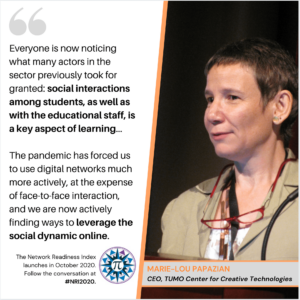This is part of our Dialogue on Digital Transformation series, in advance of the upcoming 2020 Network Readiness Index.
Marie Lou Papazian is the CEO of the TUMO Center for Creative Technologies. Prior to joining TUMO, Marie Lou led the Education for Development Foundation (the Three Pomegranates Network), which helped connect Armenian students to global peers using online educational platforms and activities.

In which ways does the education sector have to be digitally transformed?
In education, everyone is now noticing what many actors in the sector previously took for granted: social interactions among students, as well as with the educational staff, is a key aspect of learning. And not just in terms of socialization and inclusiveness, but also, and most importantly, in terms of achieving significant learning outcomes. The pandemic has forced us to use digital networks much more actively, at the expense of face-to-face interaction, and we are now actively finding ways to leverage the social dynamic online.
The digital transformation we are now undergoing is now largely driven by the move from in-person to remote. We are having to quickly retool important aspects of our education strategies and, as a very positive side effect, we are building more solid pedagogical foundations by being deliberate about every aspect of the social dynamics we previously took for granted.
We are also realizing that we can’t just replicate the in-person online. Using standard video conferencing software is only a stopgap. The education community needs to take on a leadership role in developing new software tools. While software engineering may not be our core competency, for many of us, creating learning environments is. Not only are we well placed to design products for collaborative online learning, we also have the most to gain from well-designed solutions, optimized for learning communities that are distributed across different locations, whether in students’ homes, or in online classrooms in remote localities – and the most to lose if they don’t become available soon.
How have you observed the digital divide in education due to COVID-19?
When it comes to branching the digital divide, the pandemic, and more generally, rapid transformations in how and where we interact (socially, professionally and in education) have led us to an unstable equilibrium. Things can tip to one side, towards a narrowing of the divide, or to the other, exacerbating it. As classrooms and other educational resources move online, in part or in whole, these resources can suddenly become globally available. They are now potentially accessible to those who simply lived too far from developed urban centers but are now connected to the increasingly online resources provided by those centers. Unless, of course, they are not connected to them because they do not have efficient access to networks and the required devices.
So, what kind of leadership and strategy is required to close the digital divide?
This obviously points to the need for leadership in two aspects. The first is the simpler one: access to networks and equipment by the underprivileged should become a top priority for everyone from policymakers to grass roots organizations. The second is more complex and requires a rethinking of the economics of access to education. For learning programs like the TUMO Center for Creative Technologies that offer their services free of charge, the move to on-line raises an urgent question: If you can’t limit provision of educational services by physical access, to a local community, then demand potentially becomes unlimited and any capacity will be insufficient. Even for TUMO, which is designed for scalability, this poses a financial dilemma: charging students for access would defeat the goal of including the most vulnerable populations, who may not be able to afford even minimal fees. The leadership challenge is therefore not only about the extension of digital networks but also about the financial equation underlying equitable access.



